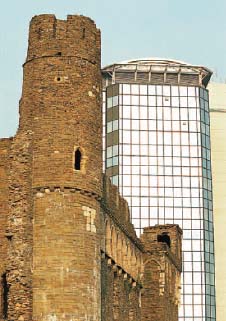
Castles gradually ceased to have a defensive role throughout much of the British Isles as society became more settled and secure. But castles came into their own again during the Civil War of the 17th century. As a result, many were destroyed in sieges, and many more were destroyed by both sides so they could not be used again. A prime example is Corfe Castle in Dorset, ‘slighted’ by the Parliamentarians after a long siege.
The Civil War also brought changes in the nature of what a defensive position was – thick, earth banks with a low profile were actually more effective protection against cannon fire than tall castle walls. Plans and drawings of the time show how sophisticated such fortifications could be.
Such ideas were not new, however. Henry VIII had been forced to build new kinds of fortresses along the coast of England as a result of threats of invasion from France and Spain. These were built from scratch with artillery in mind – both from attackers and for defence. Deal, Walmer and Sandown were built on a 2km (3-mile) stretch in Kent to protect a vital safe anchorage between the Goodwin Sands and the coast. Of these Deal is the best preserved, and shows to perfection the ideas of artillery-based fortifications: low, thick, rounded towers serve as platforms for heavy guns, while lighter guns can be fired from the ports which pierce the towers. Similar ‘castles’ (they are forts, really) were built to protect many other vulnerable anchorages and ports. These include Pendennis in Cornwall, which was later refortified with the type of angled bastions along its outer walls that were to become the norm for the next 300 years.

A martello tower off the coast of Ireland on the island called Ireland’s Eye. Martello towers were all built to a similar pattern. A single cannon was originally placed on a rotating platform on the roof, and the roof was very thick to protect from mortar fire. The body of the tower housed a garrison of men, along with their provisions and ammunition.
Another key example of new thinking in defence is the town walls of Berwick-upon-Tweed. Here, triangular bastions deflect enemy fire and enable crossfire from all angles. At Fort George in Inverness, there are very similar bastions, although these were built nearly 200 years after the walls at Berwick.
Towers have always been an important part of defensive design. There are hundreds of examples to be seen in Scotland and Ireland, with many still in use today as homes. They were practical structures used for defence until the 16th century and beyond. Later ones were built with guns very much in mind, as the array of gun ports at Dunnottar Castle in Scotland shows.
In the 19th century towers came back into fashion as defensive structures as a response to the threat of invasion from France in the Napoleonic Wars. More than a hundred were eventually built, but their guns never fired a shot in anger or defence. New developments in artillery technology – rifled barrels firing metal shells – rendered all such defences virtually useless, but in the 1860s new forts were once again built all round the coast of England. These included the last great fortifications ever built in the British Isles. Some were armour plated to withstand artillery attack.
The last threatened invasion of Britain by sea came in World War II. The answer was to refortify many of the coastal fortifications sometimes built hundreds of years before, and included the construction of thousands of pillboxes.
These tiny concrete boxes housed machine-gun emplacements, and were often cleverly and effectively disguised as such things as ice-cream kiosks, haystacks and even piles of logs. A far cry from the great castles of the likes of Edward I, they were the correct response to the ever-changing nature of war.

At Dunnottar Castle the wall nearest the mainland was equipped with gun ports, despite its conversion to a palatial residence in the late 16th century.

The battered walls of Swansea Castle framed against the shining glass of a modern office block. Whether pristine or ruined, in town or overgrown in the countryside, castles have a powerful attraction and the ability to conjure the past.